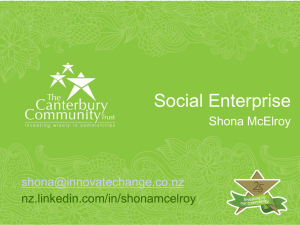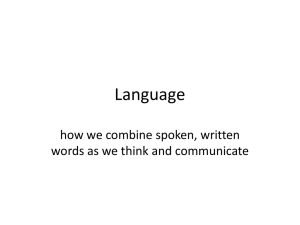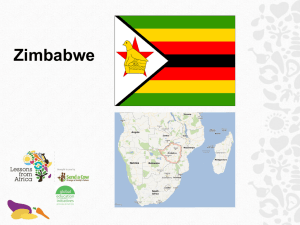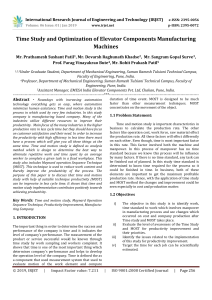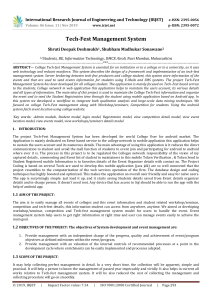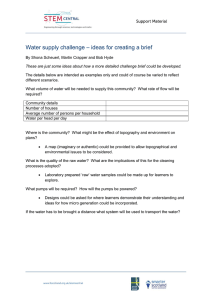IRJET- Use of Digital Technology in Teaching Native Language: A Case Study of Shona
advertisement
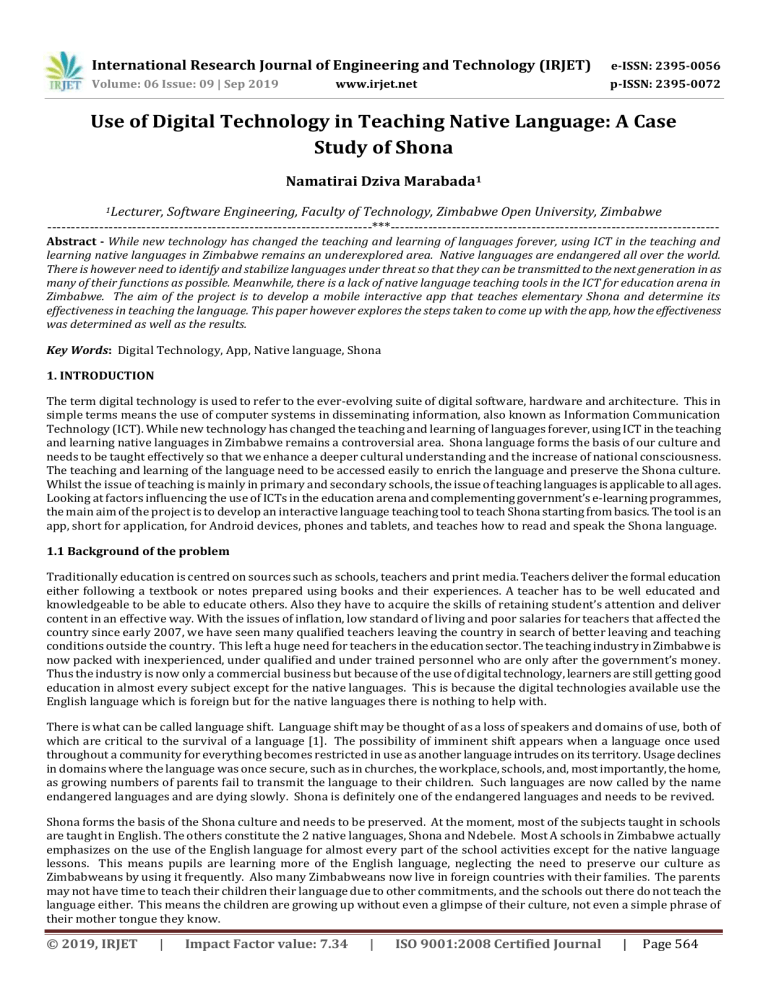
International Research Journal of Engineering and Technology (IRJET) e-ISSN: 2395-0056 Volume: 06 Issue: 09 | Sep 2019 p-ISSN: 2395-0072 www.irjet.net Use of Digital Technology in Teaching Native Language: A Case Study of Shona Namatirai Dziva Marabada1 1Lecturer, Software Engineering, Faculty of Technology, Zimbabwe Open University, Zimbabwe ---------------------------------------------------------------------***---------------------------------------------------------------------- Abstract - While new technology has changed the teaching and learning of languages forever, using ICT in the teaching and learning native languages in Zimbabwe remains an underexplored area. Native languages are endangered all over the world. There is however need to identify and stabilize languages under threat so that they can be transmitted to the next generation in as many of their functions as possible. Meanwhile, there is a lack of native language teaching tools in the ICT for education arena in Zimbabwe. The aim of the project is to develop a mobile interactive app that teaches elementary Shona and determine its effectiveness in teaching the language. This paper however explores the steps taken to come up with the app, how the effectiveness was determined as well as the results. Key Words: Digital Technology, App, Native language, Shona 1. INTRODUCTION The term digital technology is used to refer to the ever-evolving suite of digital software, hardware and architecture. This in simple terms means the use of computer systems in disseminating information, also known as Information Communication Technology (ICT). While new technology has changed the teaching and learning of languages forever, using ICT in the teaching and learning native languages in Zimbabwe remains a controversial area. Shona language forms the basis of our culture and needs to be taught effectively so that we enhance a deeper cultural understanding and the increase of national consciousness. The teaching and learning of the language need to be accessed easily to enrich the language and preserve the Shona culture. Whilst the issue of teaching is mainly in primary and secondary schools, the issue of teaching languages is applicable to all ages. Looking at factors influencing the use of ICTs in the education arena and complementing government’s e-learning programmes, the main aim of the project is to develop an interactive language teaching tool to teach Shona starting from basics. The tool is an app, short for application, for Android devices, phones and tablets, and teaches how to read and speak the Shona language. 1.1 Background of the problem Traditionally education is centred on sources such as schools, teachers and print media. Teachers deliver the formal education either following a textbook or notes prepared using books and their experiences. A teacher has to be well educated and knowledgeable to be able to educate others. Also they have to acquire the skills of retaining student’s attention and deliver content in an effective way. With the issues of inflation, low standard of living and poor salaries for teachers that affected the country since early 2007, we have seen many qualified teachers leaving the country in search of better leaving and teaching conditions outside the country. This left a huge need for teachers in the education sector. The teaching industry in Zimbabwe is now packed with inexperienced, under qualified and under trained personnel who are only after the government’s money. Thus the industry is now only a commercial business but because of the use of digital technology, learners are still getting good education in almost every subject except for the native languages. This is because the digital technologies available use the English language which is foreign but for the native languages there is nothing to help with. There is what can be called language shift. Language shift may be thought of as a loss of speakers and domains of use, both of which are critical to the survival of a language [1]. The possibility of imminent shift appears when a language once used throughout a community for everything becomes restricted in use as another language intrudes on its territory. Usage declines in domains where the language was once secure, such as in churches, the workplace, schools, and, most importantly, the home, as growing numbers of parents fail to transmit the language to their children. Such languages are now called by the name endangered languages and are dying slowly. Shona is definitely one of the endangered languages and needs to be revived. Shona forms the basis of the Shona culture and needs to be preserved. At the moment, most of the subjects taught in schools are taught in English. The others constitute the 2 native languages, Shona and Ndebele. Most A schools in Zimbabwe actually emphasizes on the use of the English language for almost every part of the school activities except for the native language lessons. This means pupils are learning more of the English language, neglecting the need to preserve our culture as Zimbabweans by using it frequently. Also many Zimbabweans now live in foreign countries with their families. The parents may not have time to teach their children their language due to other commitments, and the schools out there do not teach the language either. This means the children are growing up without even a glimpse of their culture, not even a simple phrase of their mother tongue they know. © 2019, IRJET | Impact Factor value: 7.34 | ISO 9001:2008 Certified Journal | Page 564 International Research Journal of Engineering and Technology (IRJET) e-ISSN: 2395-0056 Volume: 06 Issue: 09 | Sep 2019 p-ISSN: 2395-0072 www.irjet.net Many foreigners are settling well in Zimbabwe as their second home with an example of the Chinese and the Nigerians whose population in the country has increased tremendously over the years. Because of their age and other factors they find it difficult to enrol in primary or secondary schools to learn the native languages. They are however finding it difficult to fit in their so called second home due to language barriers. Learning the culture is also difficult as they try to do it in foreign languages. The use of digital technology in education has since been growing drastically. The government has made the effort to help students use ICTs in education by donating computers in different schools. The use of computers needs to be maximised for learning to be effective. Learning languages using computers is now possible because of the advances in ICT, such as the integration of sound, images, graphics and videos through the peripheral devices such as microphones, headphones or webcams. Language learning is very special because of the time required to understand it. One has to do a lot of repetition in order memorise and understand fully. Different skills involve continuous learning in small doses rather than all Context Authentic materials in one go. However, there is need to work towards a system that makes it easy for repetitive work and that uses digital technology hence the research question becomes: How can digital technology be used to effectively teach the Shona language? 1.2 Problem Statement There is a lack of native language teaching tools in the ICT for education arena in Zimbabwe. The native languages in Zimbabwe include Shona, Ndebele, Shangani, Tonga, Kalanga, Ndau among others. These are taught either using the old formal way of education or orally. Other areas of education have adopted the use of ICTs but the teaching of the native languages is lacking behind. This problem has resulted in the following: • Alarming decline in the use of the native languages • Zimbabwean cultures fading and alarming adoption of foreign cultures • Native languages being taught incorrectly 1.3 Justification Teaching and learning using digital technology is fundamentally changing learning abilities everywhere. This app is intended to complement the government’s e-learning programme [2] so as to allow the use of ICTs to help in educating people even from home. Mobile devices are shaping how students learn and interact through their interactive nature, ease of use and user friendliness and their use is increasing drastically. The devices include components such as sound, images, videos and graphics which capture the student’s attention increasing the student’s willingness to learn the language. The research is intended to help them to use applications, not only because they help develop language, but because they are the tools that are now commonly used for socialisation, studying and self-development, hence equipping them with communication skills necessary for the fostering of effective communication, the enhancement of deeper cultural understanding and the increasing of national consciousness. The use of digital technology to teach Shona allows students to learn with minimum supervision. 2 Literature Review 2.1 Native languages A native language also known as mother tongue, refer to the language of one’s ethnic group and the one a person has learned from birth or that a person speaks the best, hence it is often the basis for sociolinguistic identity. Native languages around the world are slowly dying despite their importance to culture. There is however need to revitalise native languages using the best possible forms. Native languages are endangered all over the world [3]. There is a predicted alarming decline in the number of languages. Some think that as many as 60% to 90% of the world's approximately 6900 languages may be at risk of extinction within the next 100 years. An average of one language every 2 weeks may vanish over the next 100 years [4]. Of the 155 native languages found in United States only 20 were still spoken by people of all ages [3]. There is definitely what can be called language shift which may be thought of as a loss of speakers and domains of use, both of which are critical to the survival of a language [1]. The possibility of imminent shift appears when a language once used throughout a community for everything becomes restricted in use as another language intrudes on its territory. Usage declines in domains where the language was once secure, such as in churches, the workplace, schools, and, most importantly, the home, as growing numbers of parents fail to transmit the language to their children. © 2019, IRJET | Impact Factor value: 7.34 | ISO 9001:2008 Certified Journal | Page 565 International Research Journal of Engineering and Technology (IRJET) e-ISSN: 2395-0056 Volume: 06 Issue: 09 | Sep 2019 p-ISSN: 2395-0072 www.irjet.net The reason why this endangerment increased and/or is still increasing is the enduring differences among the expansionary potentials of different peoples, of the kind that might cause the sustained expansion of a single, dominant language. Over the past 10,000 years, various events have punctured this equilibrium forever [1]. In her article she says invention and spread of agriculture was first, followed by the rise of colonialism, then the Industrial Revolution, and today globalisation and electronic technology, have created what she calls the global village phenomenon. Native languages do not only carry speech, but also carry with them an unspoken network of cultural values. These values are a major force in the shaping of each person’s self-awareness, identity and interpersonal relationships [3]. They say cultural values help in generating and maintaining an individual's level of comfort and self-assurance and, consequently, success in life. Normally these values are absorbed along with one's mother tongue in the first years of life. For that reason, cultural values and mother tongue are so closely intertwined in public consciousness that they are often inseparable. The native language is linked to culture. Loss of language is part of a much larger process of loss of cultural and intellectual diversity in which some dominant language and culture simply overwhelm indigenous languages and cultures, placing them in a condition which can be described as endangered. The preservation of a language in its fullest sense ultimately entails the maintenance of the group who speaks it, and therefore the arguments in favour of doing something to reverse language death are ultimately about preserving cultures and habitats [1]. There is however need to identify and stabilise languages under threat so that they can be transmitted to the next generation in as many of their functions as possible. Languages are at risk when they are no longer transmitted naturally to children in the home by parents or other caretakers. The prospect of the loss of linguistic diversity on such a large scale has prompted both communities and scholars to propose programs of intervention to preserve and revitalise languages., view endangered languages as a ‘hopeless cause’, while regarding documentation as an urgent scientific task. Estimates of the costs of providing adequate documentation range from around $55,000 per language to fund 2 years of work by a linguist to provide a basic dictionary and grammar to $2 million per language to fund an in-depth study over 15 years, complete with audio-visual archives and other comprehensive materials [1]. Communities around the world have increasingly looked to schools and other teaching programs as a way to revitalise their languages [1]. Revitalisation activities of these various types, however, will not save languages without firm community foundations for transmission. There is an important distinction to be made between learning a language in the artificial environment of the classroom and transmitting it in the natural environment of the home. 2.2 Education system in Zimbabwe Traditionally education is centred on sources such as schools, teachers and print media. Teachers deliver the formal education either following a textbook or notes prepared using books and their experiences. A teacher has to be well educated and knowledgeable to be able to educate others. Also they have to acquire the skills of retaining student’s attention and deliver content in an effective way. The current political and socio-economic environment prevailing in Zimbabwe has adversely affected the provision of basic social services. Zimbabwe’s education system is one area that has suffered a lot from the harsh socio-economic environment in the country. Most of the highly qualified and experienced teachers have left the country due to low salaries and poor working conditions, while many others have been forced to stay home just because their earnings are not even enough to cover their transport costs, to and from work [5]. This is a tragedy, taking into account the undeniable fact that the country’s education system is the backbone of social and economic progress. The country was however left with many vacancies in the education sector giving room to inexperienced and under qualified personnel to fill in the spaces. According to The Sunday News, the country has close to 30000 unfilled teaching vacancies with over 12000 filled by untrained teachers temporarily employed. It said “The staff compliment of qualified teachers is supposed to be 127 852. The Ministry of Education also revealed that there are 12 713 untrained teachers (temporary teachers) in primary and secondary schools nationwide” [6]. Meanwhile, the country has been operating with those shortages resulting in poor education standards depriving millions of students their right to quality education. Some possible measures for reviving Zimbabwe’s education system were proposed [5]. These included establishing an Education Recovery Task Force; this will come up with concrete strategies and measures for reviving the country’s education system. This force might take forever to establish and may be accompanied by huge costs. Another measure is attracting teachers back into the profession and into schools. This can be hard considering the fact that the economy is not yet stable enough to attract people back into the country 2.3 Digital Technology in education The term digital technology is used to refer to the ever-evolving suite of digital software, hardware and architecture. This in simple terms means the use of computer systems in disseminating information, also known as Information Communication Technology (ICT). Advances in digital technology have opened up many avenues in the education arena. Digital technology in education describes the use of ICT in the process of generating, creating and acquisition of knowledge through the technology. © 2019, IRJET | Impact Factor value: 7.34 | ISO 9001:2008 Certified Journal | Page 566 International Research Journal of Engineering and Technology (IRJET) e-ISSN: 2395-0056 Volume: 06 Issue: 09 | Sep 2019 p-ISSN: 2395-0072 www.irjet.net The issue of digital technology in education has seen so many debates going on about whether it brings positive effect to the education arena or is rather pulling it down or has no influence at all. Digital technologies such as computers, mobile devices, digital media creation and distribution tools, video games and social networking sites are transforming how people think about schooling and learning [7]. The need to establish the value of technology to education is very important, especially where there is an emphasis on standards-based accountability and because of the substantial cost of implementing technology innovation in the classroom[8]. The following benefits can be achieved in a well-crafted use of technology; • increased learner effectiveness or performance gains • increased learner efficiency • greater learner engagement or satisfaction • More positive student attitudes to learning A counter argument is that the same could be said of well-managed non-technology supported lessons [8]. It is not feasible to control all the aspects in the imperfect research environment of schools, so the evidence rarely allows us to state unequivocally that technology has had an efficient and effective impact on student achievement [9]. There is an argument which says that there is a difference between education and schooling. Education is a lifetime enterprise, while schooling for most encompasses only the ages from five to 18 or 21years. Even when students are in school, much of their education happens outside of school [7]. This means technology in education doesn’t mean in schools only but outside as well where there is less supervised learning and it is very much applicable there. Using a metaphor of education as groceries and the grocery truck as the delivery technology, Clark’s position was “that media are mere vehicles that deliver instruction but do not influence student achievement any more than the truck that delivers our groceries causes changes in our nutrition. Basically, the choice of vehicle might influence the cost or extent of distributing instruction, but only the content of the vehicle can influence achievement” [10]. Particular forms of technology have particular affordances and learning benefits which should influence the choice and use of pedagogy [10]. Flexible delivery provides a means of replacing labour with ICT technology through the redesign of the teaching process. 2.4 Using digital technology in teaching languages With the development of digital technologies over the past decades, the possibilities for learning and teaching languages have changed dramatically, and a plethora of ICT tools allow for a more learner-centred approach and an increased focus on interaction among students and between students and teachers. Language learning and technology covers a wide range of technological applications from e-mail, chats, blogs, and the use of multimedia. The mainly used technologies for computer aided language learning (CALL) include online learning, multimedia learning in terms of video series, language learning software and mobile language learning. Online learning means learning while connected to the internet. Available online language learning tools includes the Visual Link Languages. Visual Link Languages was created by the U.S. Institute of Languages and exists to help people bridge communication gaps and to give back to the world in which we live. It teaches several languages including Spanish, French, Italian, Japanese, German, Chinese, Russian and English. For each language there is the language dictionary, and provides audio assists for pronunciation. There is also a Shona teaching online site called Introductory Shona Language (Available at http://www.shonalanguage.info/index.htm Accessed 13 November 2012). The site contains an introduction to the Shona language in English as well as links to other Shona language-related sites. The site was developed by Cameron Smith and teaches Shona using text only. No other elements such as sound or pictures are included. 3. Methodology The researcher used Agile Development Model (ADM), which is an object-oriented development methodology. ADM is based on iterative development, wherein the entire software development life-cycle is broken down into smaller iterations (or parts). The project scope and requirements are clearly laid down, at the start of the development process. This type of model helps to minimize the overall risk and lets the project adapt to changes quickly. To develop the system, the researcher is going to use: 1. Android SDK - A software development kit that enables developers to create applications for the Android platform. The Android SDK includes sample projects with source code, development tools, an emulator, and required libraries to build Android applications. Applications are written using the Java programming language. © 2019, IRJET | Impact Factor value: 7.34 | ISO 9001:2008 Certified Journal | Page 567 International Research Journal of Engineering and Technology (IRJET) e-ISSN: 2395-0056 Volume: 06 Issue: 09 | Sep 2019 p-ISSN: 2395-0072 www.irjet.net 2. Java – Android applications are developed using the Java language. As of now, that’s really the only option for native applications. The development environment will be Eclipse Indigo. Eclipse is suitable for Java projects because of its explicit recognition of Java paradigms. It also has a built in compiler which makes the developer’s work less and less difficult. The coding environment is intuitive for programming. Android relies heavily on these Java fundamentals found in Eclipse. Some of the Java’s important core features are: • It’s easy to learn and understand • It’s designed to be platform-independent and secure, using virtual machines • It’s object-oriented 3. Android Development Tools (ADT) - The Android Developer Tools (ADT) plugin for Eclipse was used. It provides a professional-grade development environment for building Android apps. It's a full Java IDE with advanced features to help one build, test, debug, and package your Android apps. 4. XML - Extensible Markup Language is a flexible way to create common information formats and share both the format and the data on the World Wide Web, intranets, and elsewhere. In addition to Java code, Android projects (and their developers) have the ability to utilize XML to perform many standard tasks. Some XML usage is required, such as the definition of the projects and its components. Much of XML's usage is optional, making many common tasks easier. The Android XML schema is highly flexible and may be used in combination with code, exclusively, or not at all. System Development Life Cycle Models There exist various software development approaches, aptly defined and designed, which are employed during the development process of software. These approaches are also referred to as 'Software Development Life Cycle Models'. System Development Lifecycle (SDLC) models that are commonly used are: • Prototyping • Spiral Model • Waterfall Model • Rapid Application Development (RAD) • Agile Development Model (ADM) The researcher adopted ADM for the development of the Shona Teaching App. Below is a detailed description of the Agile Development Life Cycle as well as the reasons for use in this research. 3.1. Agile Development Model (ADM) Agile Development Model (ADM), is a group of software development methods based on iterative and incremental development, where requirements and solutions evolve through collaboration between self-organizing, cross-functional teams. It is an object-oriented development methodology where the entire software development life-cycle is broken down into smaller iterations (or parts). The project scope and requirements are clearly laid down, at the start of the development process. The development team defines the requirements for the iteration, develops the code, and defines and runs integrated test scripts, and the users verify the results see Fig 1. Verification occurs much earlier in the development process than it would with other models such as waterfall, allowing stakeholders to fine-tune requirements while they’re still relatively easy to change. Thus, the output of each iteration is working code that can be used to evaluate and respond to changing and evolving user requirements. This type of model helps to minimize the overall risk and lets the project adapt to changes quickly. Agile Development Model is based on two different philosophies namely Extreme Programming (XP) and Scrum. XP concentrates on the development rather than managerial aspects of software projects. XP projects start with a release planning phase, followed by several iterations, each of which concludes with user acceptance testing. When the product has enough features to satisfy users, the team terminates iteration and releases the software. Unlike XP, Scrum methodology includes both managerial and development processes. The Scrum development process concentrates on managing sprints. Before each sprint begins, the team plans the sprint, identifying the backlog items and assigning teams to these items. Teams develop, wrap, review, and adjust each of the backlog items. © 2019, IRJET | Impact Factor value: 7.34 | ISO 9001:2008 Certified Journal | Page 568 International Research Journal of Engineering and Technology (IRJET) e-ISSN: 2395-0056 Volume: 06 Issue: 09 | Sep 2019 p-ISSN: 2395-0072 www.irjet.net Fig 1 ADM Model at high level The researcher adopted the XP philosophy. This can be illustrated by Fig 1 above and is described in detail below. Pre-Iteration Planning The goal during this period is to initiate the project by garnering initial support for the project, actively working with stakeholders, starting to build the team, modelling an initial architecture for the system, setting up the environment and estimating the project. These activities are discussed in detail below. Garnering initial support and funding for the project: This is where a project proposal is written which provides reasonable answers to questions like how much is it going to cost, how long is it going to take as well as justifying the need for the project. The output is a permission to work on the project. Actively working with stakeholders to initially model the scope of the system: This is the initial requirements modeling with the stakeholders to identify the initial, albeit high-level, requirements for the system. The goal is to understand the problem and solution domain, not to create mounds of documentation. Starting to build the team: At this point you will want to have at least one or two senior developers, the project coach/manager, and one or more stakeholder representatives. Modeling an initial architecture for the system: Early in the project you need to have at least a general idea of how you're going to build the system. Is it a mainframe COBOL application? A .Net application? J2EE? Something else? Android application in this case. The goal is to identify an architectural strategy, not write mounds of documentation. Setting up the environment: You need development tools for the team. You don't need access to all of these resources right away, although at the start of the project you will need most of them. Estimating the project: You'll need to put together an initial estimate for your agile project based on the initial requirements, the initial architecture, and the skills of your team. This estimate will evolve throughout the project. Post Iteration Consolidation Final system and acceptance testing should be performed at this point, although the majority of testing should be done during construction iterations. You may choose to pilot/beta test your system with a subset of the eventual end users. There is no value in testing the system if you don't plan to act on the defects that you find. You may not address all defects, but you should expect to fix some of them. Finalization of any system and user documentation is also done here. There is also training of end users, operations staff, and support staff to work effectively with our system then eventually the system is deployed. To understand the agile development life cycle better, figure 2 shows a low level diagram of the whole agile development process. © 2019, IRJET | Impact Factor value: 7.34 | ISO 9001:2008 Certified Journal | Page 569 International Research Journal of Engineering and Technology (IRJET) e-ISSN: 2395-0056 Volume: 06 Issue: 09 | Sep 2019 p-ISSN: 2395-0072 www.irjet.net Fig 2 ADM Model at low level Use Case Model The model uses Use Case and Actor classes. Use cases are used to identify and partition functionality. The actor classes are used to model and represent roles for users of a system, including human users and any other system. In this project, we have only one actor, which is the Student. Actors however are not just humans. They can also be computers, pieces of hardware, or even other software systems. The only criterion is that they must be external to the part of the system being partitioned into use cases. The use case classes are used to model and represent units of functionality or services provided by the system to users. The use cases are denoted as ellipses or ovals that may be enclosed by a system boundary or rectangle with the name of the containing system. Below is the use case diagram of the Shona Teaching App followed by a series of descriptions of the various use cases. Fig 3 Use Case Model © 2019, IRJET | Impact Factor value: 7.34 | ISO 9001:2008 Certified Journal | Page 570 International Research Journal of Engineering and Technology (IRJET) e-ISSN: 2395-0056 Volume: 06 Issue: 09 | Sep 2019 p-ISSN: 2395-0072 www.irjet.net The data recorded was then retrieved from the response sheet for the purpose of designing the much simplified graphical presentations as (shown below). GRAPHICAL PRESENTATION FOR QUESTION ONE (Q1) Please indicate your gender. Male 15 Female 15 The graphical design indicates that sample size was represented equally in terms of gender. Equal representation is an attempt to restrain from any gender bias that may be through unequal representation in the research process. GRAPHICAL PRESENTATION FOR QUESTION TWO (Q2) Indicate your level of knowledge of the Shona Language No Knowledge Little Knowledge Male 0 Female 0 Male 15 Female 15 100% of the respondents, both male and female, stated that they had little knowledge of the Shona language. This shows that the study can yield correct results since the target population is composed of people with little knowledge of the Shona language as assumed earlier. © 2019, IRJET | Impact Factor value: 7.34 | ISO 9001:2008 Certified Journal | Page 571 International Research Journal of Engineering and Technology (IRJET) e-ISSN: 2395-0056 Volume: 06 Issue: 09 | Sep 2019 p-ISSN: 2395-0072 www.irjet.net GRAPHICAL PRESENTATION FOR QUESTION THREE (Q3) If you have some knowledge of the Shona language, how have you been learning it? Orally Reading Multimedia Male 4 Female 4 Male 11 Female 11 Male 0 Female 0 The above information shows that 73% of the respondents have been learning Shona orally, while 27% have been learning it through reading books or studying. None of the respondents stated that they have used some multimedia means in learning Shona. This, to a greater extent, shows that there is really a lack of multimedia (i.e. ICT) tools in the ICT for education arena in Zimbabwe. GRAPHICAL PRESENTATION FOR QUESTION FOUR (Q4) What is your native language? Ndebele Shangani Tonga © 2019, IRJET | Impact Factor value: 7.34 | Male 12 Female 14 Male 2 Female 0 Male 1 Female 1 ISO 9001:2008 Certified Journal | Page 572 International Research Journal of Engineering and Technology (IRJET) e-ISSN: 2395-0056 Volume: 06 Issue: 09 | Sep 2019 p-ISSN: 2395-0072 www.irjet.net From the responses concerning the native language the participants belongs to, 93% of the females indicated Ndebele while only 7% indicated Tonga as their native language but none of the females speak Shangani. As for the males, 80% speak the Ndebele language, 13% speak Shangani and only 7% speak Tonga. This information shows that there are really non-Shona speakers living in Zimbabwe. GRAPHICAL PRESENTATION FOR QUESTION SIX and SEVEN (Q6 and Q7) Q6 Please enter the Shona equivalence of the following numbers Q7 Please enter the Shona equivalence of the following months of the year Marks Before 30 Marks After 30 The above graph shows the results of the identical tests given to the participants. One test was given before the participants were given the Shona Teaching App to teach them the language and the other test was given after their interaction with the app. From the graph, almost all the participants managed to improve their scores with an average improvement rate of 23%. The results however show that, to a greater extent, ICTs can be effective in the teaching and learning of native languages such as Shona. The results also shows that the females has a better improvement rate than the male counterparts, thus, the females had an average improvement rate of 28% whilst the males had only 28%. Other findings from the data show that the Tongas are more likely to improve their Shona through use of ICTs than the other language speakers. The following graph shows the change in the test results against the participants’ native languages. It © 2019, IRJET | Impact Factor value: 7.34 | ISO 9001:2008 Certified Journal | Page 573 International Research Journal of Engineering and Technology (IRJET) e-ISSN: 2395-0056 Volume: 06 Issue: 09 | Sep 2019 p-ISSN: 2395-0072 www.irjet.net shows that the Tongas improved more than the other language speakers with an improvement rate of 45% followed by the Ndebeles with 22% improvement rate and the Shanganis had an improvement rate of only 16%. 4. Conclusion and Recommendations 4.1 Realisation of Objectives and user requirements A mobile interactive application that teaches the Shona language was developed and the effectiveness of such a system was tested. To come up with the application a number of user requirements were set. The success of a project is dependent on the ability to accomplish these requirements. It is essential that most or all of the requirements are met. The researcher managed to meet the following requirements: Allow users to read different words in both Shona and English Allow users to listen to the correct pronunciation of all the Shona syllables Allow users to record their own pronunciations Provide quizzes to test users’ understanding Provide a word search 4.2 Challenges encountered Although a lot of positive achievements have been noted some of the challenges that were faced during the project were as follows: Gaining proficiency in the use of some of the tools: A lot of time was spent learning and getting accustomed to XML which was the adopted for the user interface. Also a lot of time was spent experimenting on some of the Android programming terminology in Java and SQLite as the system developer had very little knowledge of the two. Limited application domain knowledge: Having little appreciation for the teaching and learning of the Shona language meant that the system developer had to learn a lot of terminology from scratch. Shona is a very complicated language to teach as illustrated by the teachers interviewed. This also meant that the researcher had to study different pedagogics to be able to adopt some of them. Limited implementation space: The researcher only managed a small database with just a few words in it. This was due to the fact that the device on which the app is run has very limited memory and a full implementation would cause the device to respond very slowly. The solution was to have the database, images and sounds be hosted in a remote server and have the system access them only when needed and over the internet. This was however costly for the researcher and needed more time to implement though this would allow the system to upgraded easily. © 2019, IRJET | Impact Factor value: 7.34 | ISO 9001:2008 Certified Journal | Page 574 International Research Journal of Engineering and Technology (IRJET) e-ISSN: 2395-0056 Volume: 06 Issue: 09 | Sep 2019 p-ISSN: 2395-0072 www.irjet.net 4.3 Recommendations The researcher recommends that more tests be taken to verify the effectiveness of using digital technology in teaching native languages. For example, the same participants may be given another test or more to check if they are really improving in their learning. Or, other groups especially of foreign languages, such as the Chinese, Indians or English, can be used to take these tests and see how they can perform. A lot of further improvements can be made to the Shona Teaching App so as to improve its functionality and broaden the scope of the current system. The system can be improved to be more effective in teaching the language by adding other pedagogics such as the use of songs. Culture notes such as the national anthem of Zimbabwe, totems and other culture songs can also be included so as to enhance a better cultural understanding. REFERENCES [1] Romaine S, “Preserving Endangered Languages” (2006), University of Oxford [2] Ministry of Information Communication Technology (MICT) Strategic Plan 2010 – 2014, page 21 [3] Reyhner J. and Tennant E., “Maintaining and Renewing Native Languages” (2006), Northern Arizona University and Educational Research Associates [4] Crystal D. “Language death “ (2000), UK: Cambridge University Press. [5] Sinyolo D., “Strategies for reviving Zimbabwe's education system” (2009), Newzimbabwe.com [online] Available at http://newzimbabwe.com/pages/fees44.19257.html Accessed 12 November 2012 [6] Chiwanga S., “30 000 teacher vacancies unfilled in Zimbabwe” (2012), The Sunday News: 29 April 2012 [7] Collins A. & Halverson R., “The second educational revolution: rethinking education in the age of technology” (2010) Northwestern University, Evanston, IL, USA and University of Wisconsin, Madison, WI, USA. [8] Underwood J, “The impact of digital technology” (2009) Nottingham Trent University [9] Protheroe, N., “Technology and Student Achievement. Principal- Effective Intervention” (2005) Research Report, 85, 46-48. [10] Sappey J Dr and Relf S, “Digital Technology Education and its Impact on Traditional Academic Roles and Practice” (2010), Charles Stuart University. © 2019, IRJET | Impact Factor value: 7.34 | ISO 9001:2008 Certified Journal | Page 575
